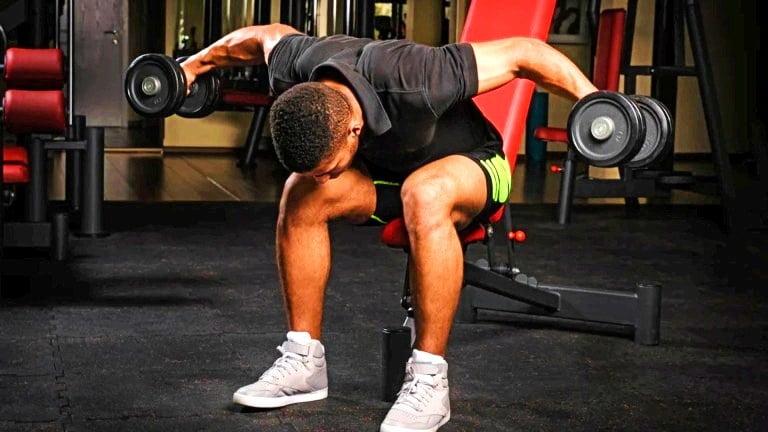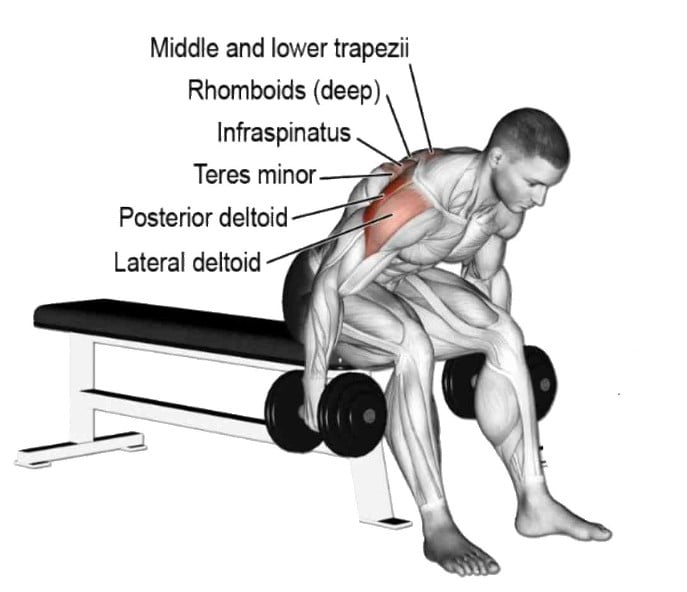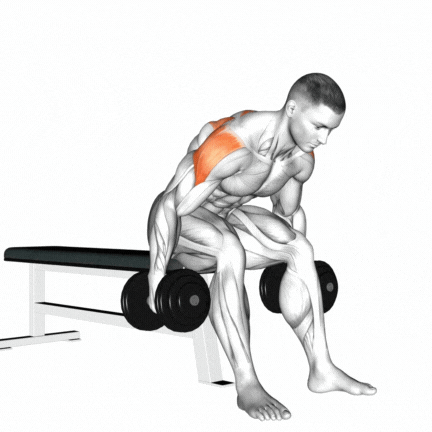The seated dumbbell rear delt fly, also known as the seated bent-over reverse delt fly, is an upper-body exercise that targets your upper back and shoulder muscles.
It is one of the best variations of the dumbbell rear delt fly for isolating and working specifically on rear deltoid muscles. I must add it to my shoulder workout routine.
You can perform this exercise while standing, with your torso bent over (reverse dumbbell fly). However, doing it in a seated position reduces your chances of cheating and eliminates momentum from the rest of the body.
This movement is usually performed for moderate to high reps.
Know More: Rear Delt Fly: Muscles Worked, Benefits, Variations

Seated Dumbbell Rear Delt Fly Muscles Worked
The Seated rear delt dumbbell fly primarily on the muscle-worked rear deltoid.
The seated dumbbell delt fly involves several other muscles in addition to the target, the rear delt muscles. These muscles include the Lateral deltoid, Trapezius, Rhomboids, Infraspinatus, and teres minor, teres major.

How To Do Seated Dumbbell Rear Delt Fly
- Sit on the end of a flat bench or chair with your feet firmly planted.
- Lean forward from your hips while maintaining a straight back.
- Grab a dumbbell in each hand using an overhand grip (palms facing down). Let the weights hang straight down with your arms extended.
- Slightly bend your elbows and raise your arms out to the sides in a wide arc.
- You should continue this movement until your upper arms parallel the floor or slightly higher.
- Then, slowly lower the dumbbells back to their starting position.
- Do 8–12 reps and 3–4 sets, taking a 60- 90-second rest between sets.

Tips And Form For Seated Rear Delt Fly
- Keep a controlled motion and avoid jerky movements.
- Start with lighter weights to focus on technique and form.
- Throughout the exercise, keep your elbows slightly bent. Avoid fully extending or locking out your elbows.
- Perform the exercise slowly and calmly, emphasizing the eccentric (lowering) phase.
- Exhale as you pull your arms back, and inhale as you come back. Keep your breathing steady throughout the exercise.
- Your oblique muscles must be engaged to sustain a stable torso throughout the movement.
- You should aim to complete 3–4 sets of 10–12 reps of the dumbbell rear delt fly.
- Perform the exercise 2–3 times a week for optimal results.
- Pair it with other exercises targeting different shoulder parts for a well-rounded workout.
- As you become more comfortable with the form, change your set and rep ranges to challenge yourself.

Want to take your gains to the next level? Discover your daily calorie needs with our free TDEE calculator
Single-Arm Seated Rear Delt Fly
Changes and progress can make your workouts harder and prevent plateaus in your shoulder training.
The single-arm variation helps address strength or size imbalances between your left and right rear deltoids. This can make the shoulder more stable and prevent injuries caused by muscle imbalances.
How To Do
- Sit on a bench with a dumbbell in one hand (palm facing inward).
- Bend your torso slightly forward, maintaining a flat back and a neutral spine.
- Start with your arm hanging down naturally toward the floor.
- Exhale and slowly raise the dumbbell to the side.
- Inhale and lower the dumbbell back to the starting position.
- Complete the desired repetitions with one arm before switching to the other side.

Manish is a NASM-certified fitness and nutrition coach with over 10 years of experience in weight lifting and fat loss fitness coaching. He specializes in gym-based training and has a lot of knowledge about exercise, lifting technique, biomechanics, and more.
Through “Fit Life Regime,” he generously shares the insights he’s gained over a decade in the field. His goal is to equip others with the knowledge to start their own fitness journey.
